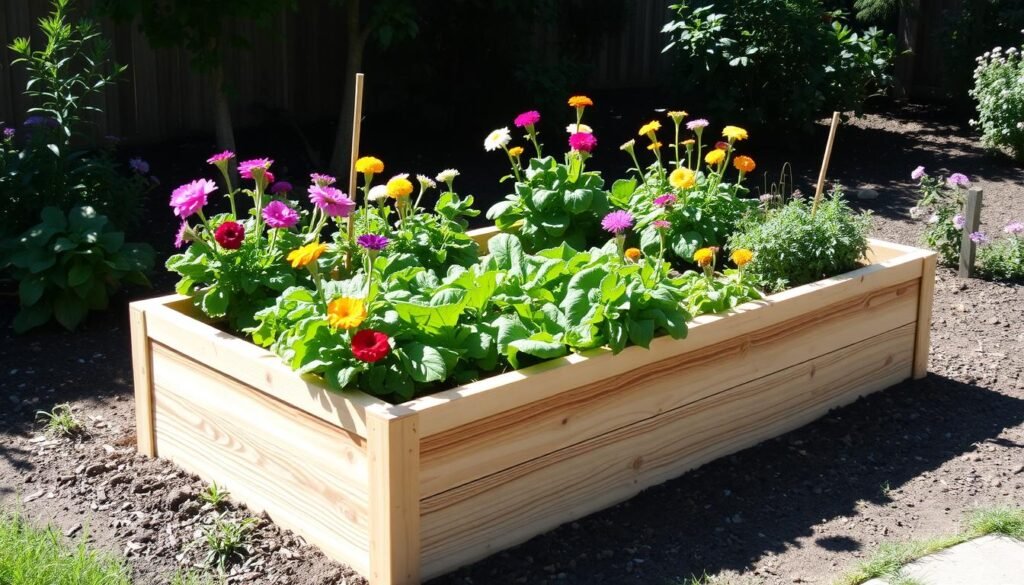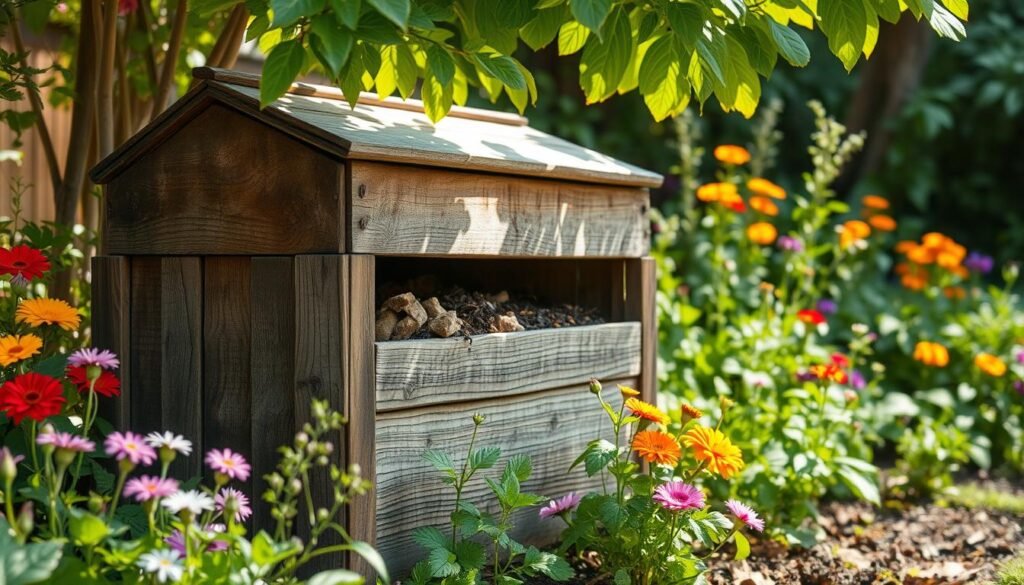Are you tired of the same old garden paths? Unlock the endless possibilities of transforming your outdoor haven with DIY garden pathways that showcase your creativity and sustainability. Imagine strolling through a lush, personalized oasis, where every step sparks joy and inspiration. In this article, we’ll uncover a world of innovative ideas to design and build stunning garden paths using recycled materials, from bricks and paving stones to gravel and wood chips.
Intrigued by the prospect of crafting your own unique garden walkways? Prepare to be inspired as we explore a treasure trove of budget-friendly and environmentally conscious solutions that will breathe new life into your outdoor space. Whether you’re a seasoned gardener or a beginner eager to personalize your backyard, this article will guide you through the process of creating a visually stunning and functional DIY garden pathway.
Creative ideas for designing and building garden pathways using materials like bricks, paving stones, gravel, and wood chips
Creating a stunning garden pathway doesn’t have to be expensive. By repurposing common materials like bricks and paving stones, you can add charming, old-world character to your outdoor space. Arrange these recycled materials in various patterns to achieve a unique, eye-catching look.
Bricks and Paving Stones
Bricks and paving stones are versatile options for garden pathways. Try laying them in a herringbone or basketweave pattern for a classic aesthetic. You can also mix and match different shapes and sizes to add visual interest. Consider using recycled bricks or salvaged paving stones to add an eco-friendly touch to your design.
Gravel and Wood Chips
Gravel and wood chips are affordable, low-maintenance materials that can transform your garden pathways. Spread a layer of gravel or wood chips over a compacted base to create a natural, rustic look. Experiment with different sizes and textures to find the perfect fit for your outdoor space. These materials are not only budget-friendly but also easy to maintain, making them a practical choice for your garden.
With a little creativity and some recycled materials, you can design garden pathways that are both visually appealing and eco-friendly. Embrace the natural charm of bricks, paving stones, gravel, and wood chips to create a one-of-a-kind oasis in your backyard.
Unleash Your Creativity with Recycled Materials
Crafting beautiful garden pathways doesn’t have to be expensive. The true beauty often comes from repurposing everyday items. This turns them into unique and sustainable features. From recycled concrete to discarded tires, the possibilities are endless for creating stunning garden paths.
Using decomposed granite or crushed shells is a budget-friendly option. These materials offer a natural, rustic look and excellent drainage. They also provide a firm, stable surface for foot traffic. Stepping stones made from old bricks, paving stones, or broken pottery add charming, personalized touches.
- Repurpose old tires as unique and durable stepping stones
- Create custom stepping stones using molds and cement
- Incorporate recycled glass, broken tiles, or seashells for a one-of-a-kind look
- Experiment with different textures and colors to add visual interest
By embracing recycled materials, you can unleash your creativity. Transform your garden into a unique and sustainable oasis. Whether it’s a charming walkway or stunning stepping stones, the possibilities are endless. Think outside the box and embrace the power of recycled materials.
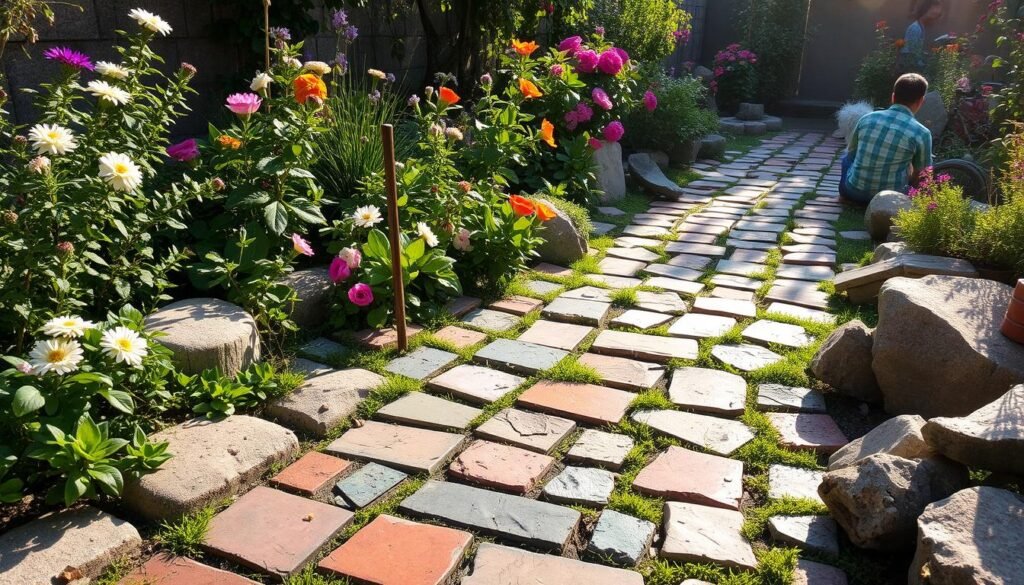
Step-by-Step Guide to Building a Stunning Garden Path
Creating a captivating garden path requires careful planning and preparation. By meticulously planning the layout and preparing the ground, you can craft a visually stunning pathway. This pathway will not only enhance your outdoor space’s aesthetic but also ensure durability and functionality.
Planning and Layout
The first step is to plan the pathway’s layout. Measure the area where you plan to install the path, considering your garden’s size and shape. Sketch out design ideas, experimenting with shapes, curves, and angles. This will help you find the most appealing arrangement.
After deciding on a layout, position the pathway strategically. Aim for a natural flow that guides the eye and leads visitors through your garden. Consider the path’s placement in relation to other garden features, like flower beds and seating areas, for a cohesive design.
Preparing the Ground
Proper ground preparation is crucial for a lasting and stable pathway. Start by clearing the area of vegetation, rocks, and debris. Level the surface to ensure it’s flat and even, preventing uneven settling or tripping hazards. Add a gravel or sand base for better drainage and a solid foundation.
If water tends to accumulate, consider installing a drainage system. Options like French drains or underground pipes can divert excess moisture. This will help maintain your pathway’s integrity and prevent water damage or erosion.
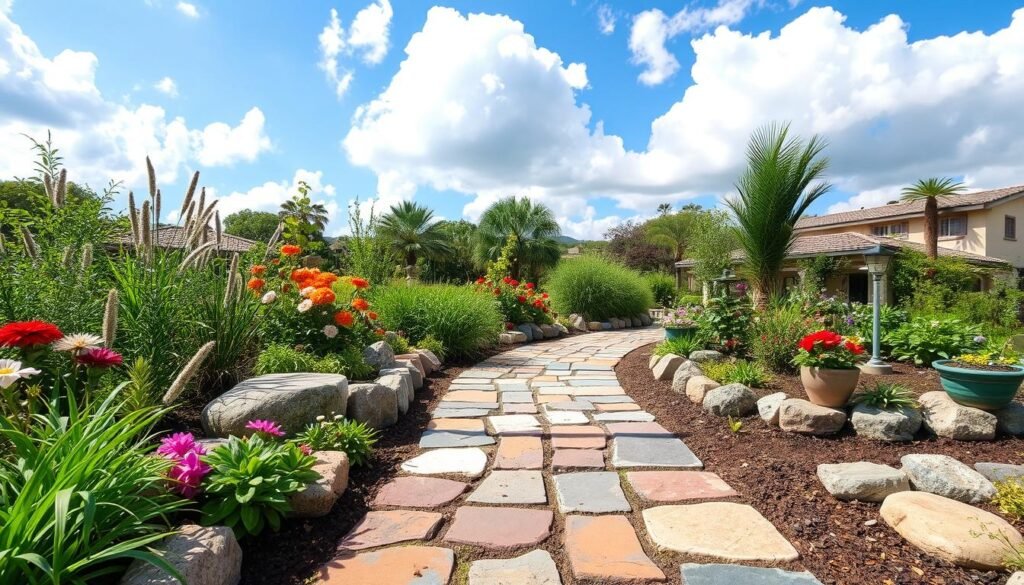
Incorporating Natural Elements for a Cohesive Look
Designing garden pathways with natural stones and rocks can achieve a seamless, organic look. This blend beautifully with the landscape. These earthy elements add visual interest and anchor the path, making it a key part of the garden’s aesthetic.
Using Stones and Rocks
Placing and arranging stones and rocks can transform your garden pathway. Large boulders or flat, smooth stones offer a rustic, natural feel. Smaller pebbles or crushed stones add texture and contrast. A mix of shapes, sizes, and colors makes the design dynamic and appealing.

When using natural elements, balance functionality with aesthetics. Ensure stones and rocks don’t block foot traffic or cause tripping. Also, consider how they interact with other materials like pavers or gravel for a cohesive look.
Embracing natural stones and rocks can elevate your garden pathway. It creates a unique, visually stunning outdoor space that blends with the environment.
Maintenance and Upkeep for Long-Lasting Pathways
Keeping your DIY garden pathways in top shape is key to their longevity and appeal. Regular care ensures your investment remains worthwhile and your outdoor area looks unified. From cleaning to minor repairs, here are some practical steps to maintain your pathways’ beauty.
Cleaning and Weeding
Regular sweeping or hosing down your pathways removes debris and prevents weed growth. This action not only improves their look but also avoids potential hazards. It’s also important to pull weeds promptly to avoid damage to your pathway’s structure.
Addressing Repairs
Even with proper care, your pathways might develop minor issues like cracks or uneven surfaces. It’s vital to fix these problems quickly to ensure safety and longevity. Depending on the material, you might need to re-level, replace, or seal the surface.
| Pathway Material | Maintenance Recommendations |
|---|---|
| Brick | Regularly sweep, power wash to remove dirt and moss, and replace any cracked or damaged bricks. |
| Paving Stones | Sweep, hose down, and use a joint stabilizer to secure loose stones. Address uneven surfaces by re-leveling the ground. |
| Gravel | Rake and refill any areas that have become sparse or uneven. Consider using a gravel binder to stabilize the surface. |
| Wood Chips | Regularly replenish the wood chips to maintain a uniform depth and appearance. Remove any weeds or debris. |
By adhering to these maintenance and upkeep guidelines, your DIY garden pathways will continue to beautify and function well in your outdoor space for many years.

Inspiration and Ideas from Garden Enthusiasts
Designing captivating garden pathways is a task filled with endless inspiration from seasoned gardeners and landscape experts. Discover a variety of unique designs that can transform your outdoor space and spark your creativity.
Showcasing Unique Designs
Both homeowners and professionals have created remarkable garden pathways that seamlessly blend form and function. These pathways showcase the endless possibilities for personalizing your garden’s look and feel. From whimsical stone arrangements to meandering trails of reclaimed wood, the options are vast.
Consider a homeowner in the Midwest who repurposed vintage bricks for a charming, winding path through lush flower beds. Or look at the stunning pavers used by a California landscape designer for a modern, geometric walkway leading to a tranquil seating area.
For a more natural aesthetic, a Pacific Northwest gardener combined river rocks and flagstone for a pathway that effortlessly blends with the foliage. Meanwhile, an East Coast homeowner used wood chips to create a warm, rustic trail through their vegetable garden.
Exploring these unique garden pathway designs can inspire you to transform your outdoor oasis. Let your creativity shine by incorporating recycled materials and natural elements. Create a one-of-a-kind path that reflects your personal style and enhances your garden’s beauty.
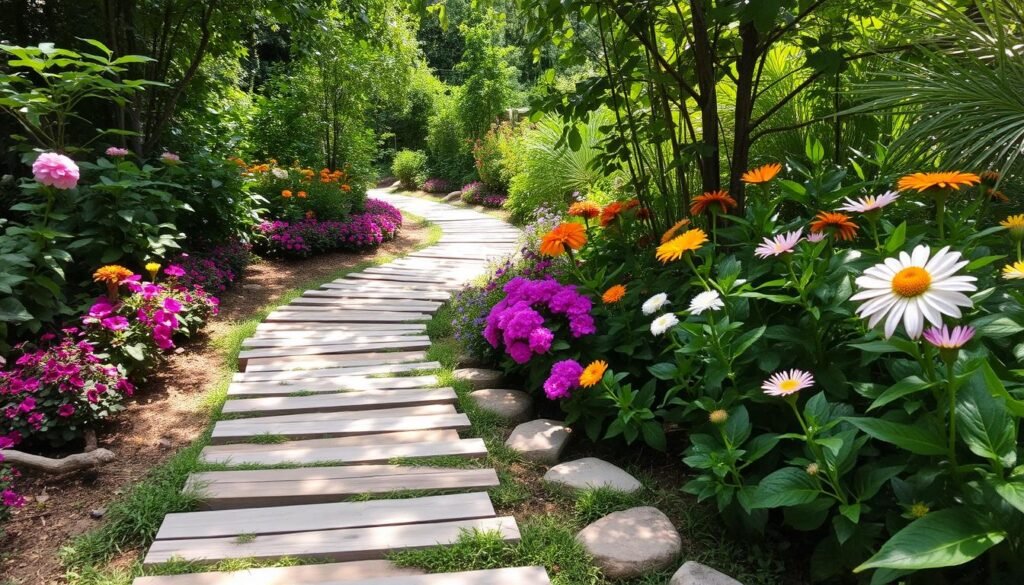
Conclusion
By using recycled and sustainable materials, you can make stunning, personalized DIY garden pathways. These pathways will not only beautify your outdoor area but also show off your unique style and care for the environment. With a bit of creativity and the right approach, your garden can become a special oasis that mirrors your personal taste.
The variety of recycled materials available is impressive, ranging from reused bricks and stones to gravel and wood chips. These options are not only budget-friendly and green but also bring beauty to your garden. They help in creating pathways that naturally fit into the garden’s setting, making it a peaceful outdoor retreat.
Whether you’re an experienced gardener or new to DIY projects, creating your own DIY garden pathways with recycled materials is a chance to express your creativity. It’s a way to make a lasting impact on your outdoor space. Take on the challenge, explore the many possibilities, and craft a garden that showcases your vision and commitment to the environment.
FAQ
What are some creative ideas for using recycled materials to build garden pathways?
Transform your garden with creative pathways using recycled materials. Consider repurposed bricks, paving stones, or gravel. Wood chips, broken concrete, or pottery can also be repurposed into stepping stones. Decomposed granite and crushed shells offer additional options for a budget-friendly approach.
How can I plan and prepare the ground for a DIY garden pathway?
Effective planning and preparation are crucial for a successful DIY pathway. Begin by measuring the area and sketching your design. Position the path for optimal visual impact. Next, clear the ground, level the surface, and ensure proper drainage. This groundwork is essential before installing your chosen materials.
What are the benefits of using natural elements like stones and rocks in my garden pathway design?
Using natural stones and rocks can create a seamless, organic look. This blend enhances the surrounding landscape. Strategically placing these elements adds visual interest and cohesion to your outdoor space.
How do I maintain and care for my DIY garden pathway over time?
Maintaining your pathway is key to its longevity. Regular cleaning, weeding, and repairs are necessary. This ensures the pathway remains visually appealing and withstands the elements for years.
Where can I find inspiration for unique garden pathway designs?
Seek inspiration from experienced homeowners and landscape professionals. Their creative designs can spark your imagination. This can help you create a personalized, unique pathway for your outdoor space.
